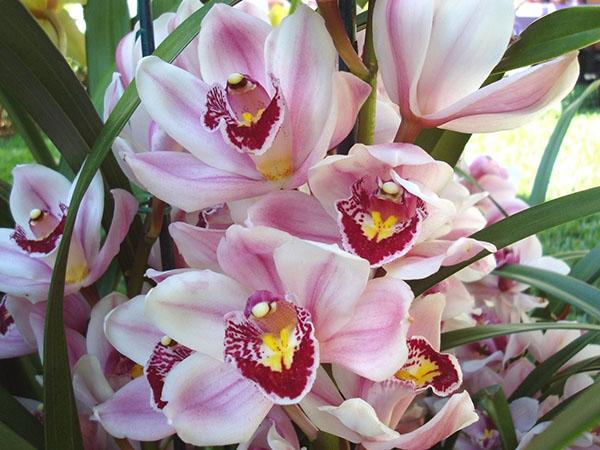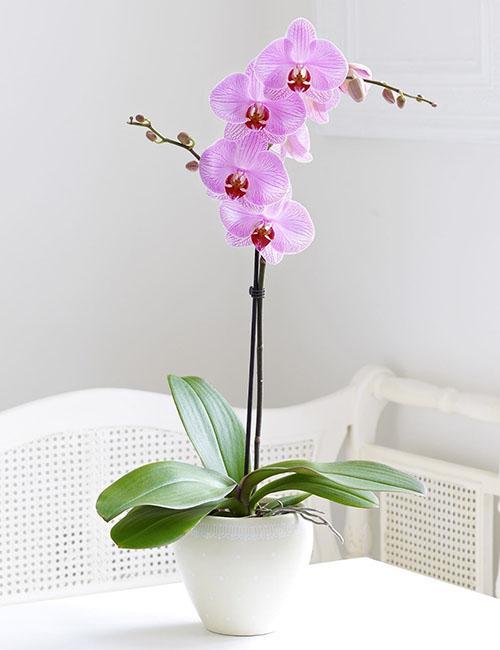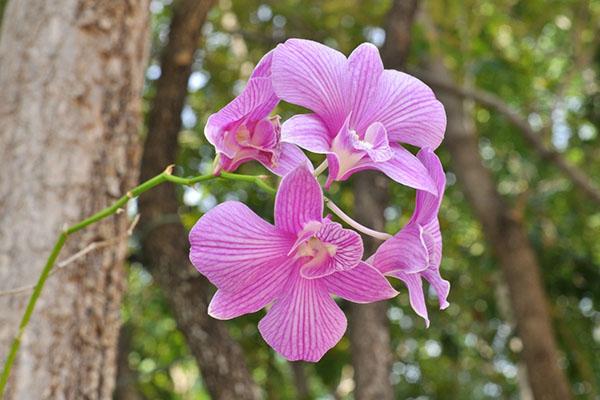Orchid pots - how to choose the right one
 Orchid inflorescences look like fluttering butterflies. This floral arrangement looks great in modern interior design. If the pots for orchids are chosen incorrectly, then over time, the charming inflorescences will cease to please the eye. Consider what containers are needed for these exotic plants.
Orchid inflorescences look like fluttering butterflies. This floral arrangement looks great in modern interior design. If the pots for orchids are chosen incorrectly, then over time, the charming inflorescences will cease to please the eye. Consider what containers are needed for these exotic plants.
Orchid species

- Epiphytes - they seem to be in limbo. They do not need a large volume of substrate, so a small vessel can be dispensed with.
- Lithophytes prefer to climb trees and rocks with the help of a powerful root system. Take root in groundless places. The roots are constantly aerated and not overheated.

- Mixed species - such flowers grow both in the ground and in limbo. The root system sticks to the rock and fills in all the crevices.
So, before purchasing a pot, you need to understand which orchid it is intended for.
How to choose the right orchid pot

When choosing a bowl for an orchid, it is worth considering the planting system:
- open;
- semi-closed;
- closed.
With an open system, the orchid is fixed between two pieces of bark and suspended in the air. The main requirement is not to overmoisten the roots.
A semi-closed system involves placing the orchid in a pot with drainage holes. Then you can insert it into the planter. For example, if a ceramic flower vessel is suitable for the interior of a room, then it is recommended that you first plant the orchid in a plastic product, and then install it in a stylish clay pots.
In the closed method, the plant is planted in a large orchid pot: a spherical vessel without drainage holes. The flower is periodically watered, through a tube or into the substrate. For 2-3 weeks, you don't have to look into such a container and not worry about watering.
Orchid pot material
When choosing pots for orchids, you should consider the design of the room. The orchid composition should fit into the overall interior. Such a task is feasible today. The modern flower market offers a huge assortment of different accessories that will satisfy the most discerning grower. The main types of products are listed below.
Plastic pots
 The plastic container creates a greenhouse effect for the plant, which protects its roots from dryness. Plastic can be placed both in a shaded place and on a windowsill brightly lit by sunlight. Such a container easily fits into a hanging planter. One plastic pot will serve several generations of a home flower.
The plastic container creates a greenhouse effect for the plant, which protects its roots from dryness. Plastic can be placed both in a shaded place and on a windowsill brightly lit by sunlight. Such a container easily fits into a hanging planter. One plastic pot will serve several generations of a home flower.
If there are not enough drainage holes, it is recommended to carefully drill them with your own hands, without violating the integrity of the bowl.
Clay containers

Clay bowls have many advantages:
- environmental friendliness;
- sustainability;
- moisture and air permeability.
Thanks to these properties, the soil is completely saturated with water and provides the plant with useful microelements.
It is not recommended to place clay pots near heating devices in order not to destroy the plant.
Over time, the pores of the clay become clogged, and the flower feels uncomfortable in such a container. In addition, the roots of the orchid grow to the inner surface of the pot. This makes it difficult to transplant the plant into another container.
If you plan to plant a plant in a clay pot, you first need to hold the product in a heated oven. Next, treat its inner surface with a disinfectant: biofungicide.
Ceramic pots
 Ceramic products are an alternative to clay products. For the production of ceramic pots, poured or unglazed ceramics are used. This prevents the roots of the plant from growing to the walls of the container.
Ceramic products are an alternative to clay products. For the production of ceramic pots, poured or unglazed ceramics are used. This prevents the roots of the plant from growing to the walls of the container.
These orchid flower pots are sustainable. They perfectly give off heat and retain moisture. It is the best choice for hot environments.
Wicker baskets
 Flower baskets can be woven from self-assembled twigs or from an artificial analogue. You can also purchase finished products. This orchid planting option is suitable for an epiphyte flower.
Flower baskets can be woven from self-assembled twigs or from an artificial analogue. You can also purchase finished products. This orchid planting option is suitable for an epiphyte flower.
Three tricky points when caring for a wicker tropical beauty:
- Usually, an orchid is watered by immersing the root in water. This is difficult to accomplish when the plant is growing in a basket.
- It is necessary to stop the regrown roots carefully so that they are not damaged.
- The wicker will dry out or soak over time.
It is recommended to put a film with holes inside the basket or put the weaving in a plastic container.
How to choose a planter for orchids
 Planter - a decorative container for home flowers without holes in the bottom. It looks much more interesting than the usual pots. The product can be made of plastic, ceramics, wood, vine, metal. Often a special pallet is included with the planter.
Planter - a decorative container for home flowers without holes in the bottom. It looks much more interesting than the usual pots. The product can be made of plastic, ceramics, wood, vine, metal. Often a special pallet is included with the planter.
Glass vases
 The roots of the orchid are long green arrows. In a stylish glass vase, such a graceful flower looks like a unique art object. Sometimes, when choosing a pot made of glass, a problem arises: it is not so easy to find a bowl with drainage holes. In addition, the whimsical flower does not tolerate excessive moisture, and it is difficult to drain water from such a container without disturbing the plant.
The roots of the orchid are long green arrows. In a stylish glass vase, such a graceful flower looks like a unique art object. Sometimes, when choosing a pot made of glass, a problem arises: it is not so easy to find a bowl with drainage holes. In addition, the whimsical flower does not tolerate excessive moisture, and it is difficult to drain water from such a container without disturbing the plant.
Florists advise using a glass bowl as a stylish planter for flowers.
How to use the orchid planter? Florists advise planting an orchid in a plastic pot. Then place the plastic in a beautiful planter. Disguise the container with a drainage layer.
Orchid bowls
 A flower planted in a bowl will fill the atmosphere of the room with notes of the east. The main problem of this product is the sustainability of flower arrangements. The inflorescence of orchids is high, so in a flat dish the plant will need a support stick.
A flower planted in a bowl will fill the atmosphere of the room with notes of the east. The main problem of this product is the sustainability of flower arrangements. The inflorescence of orchids is high, so in a flat dish the plant will need a support stick.
"Crown" - a pot for orchids
 It is a “needle-like” structure made of plastic rods that are arranged in a circle. The pot has small gaps that contain the substrate. Thanks to the special tray, drainage can be created.
It is a “needle-like” structure made of plastic rods that are arranged in a circle. The pot has small gaps that contain the substrate. Thanks to the special tray, drainage can be created.
This special orchid planter has through holes that allow moisture to drain and aerate the root system. However, due to the large ventilation, the water evaporates quickly. Watering regime is violated. All of this ends in plant disease.
Is it possible to plant an orchid in an opaque pot
 The roots of some orchid species (Phalaenopsis, Wanda) take part in photosynthesis, so it is preferable to choose a pot with transparent walls.
The roots of some orchid species (Phalaenopsis, Wanda) take part in photosynthesis, so it is preferable to choose a pot with transparent walls.
You can see through glass, polyethylene or transparent plastic:
- root development;
- moisture consumption;
- dryness or moisture of the substrate;
- damage to the root system.
Thus, keeping a flower in an opaque container requires a lot of experience in floriculture. This choice can complicate the care of the orchid and lead to flower diseases. Whereas a transparent orchid pot will eliminate any risk that contributes to the death of a tropical pet.
The perfect orchid pot
 It is not difficult to determine the optimal container size for planting a plant. The orchid prefers tightness, so its root should completely occupy the entire volume of the pot. If the root has grown too much, then the flower needs a transplant.
It is not difficult to determine the optimal container size for planting a plant. The orchid prefers tightness, so its root should completely occupy the entire volume of the pot. If the root has grown too much, then the flower needs a transplant.
What size orchid pot do you need? The height and diameter of the top of the container must be the same. It is desirable that the distance from the stem of the branch to the edge of the container is approximately 8 cm.
An orchid pot will provide a flower:
- the necessary outflow of moisture;
- aeration of the roots and earth inside the vessel;
- by carefully removing a long root, which often grows outside the pot;
- the desired temperature.
You should refuse a container with a catchy floral pattern. It will distract attention from the orchid and its magnificent inflorescence.
DIY orchid pots
 It is not difficult to make an orchid pot with your own hands:
It is not difficult to make an orchid pot with your own hands:
- Sand the wide saw cut with sandpaper, make a depression in the center. Cover the planter with varnish and place the container with the orchid inside.
- Glue colored stones to a plastic or metal pot.
- Paint a liter jar with a waterproof dye, decorate the edges with pieces of burlap.
Any old thing will sparkle with fresh colors.
 So, if you follow the above requirements, then a well-groomed orchid in a beautiful pot will become your pride.
So, if you follow the above requirements, then a well-groomed orchid in a beautiful pot will become your pride.